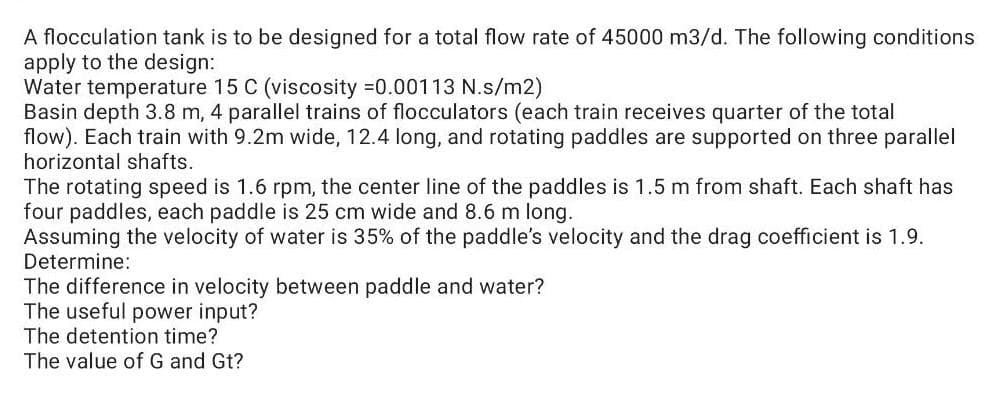A flocculation tank is to be designed for a total flow rate of 45000 m3/d. The following conditions apply to the design: Water temperature 15 C (viscosity 0.00113 N.s/m2) Basin depth 3.8 m, 4 parallel trains of flocculators (each train receives quarter of the total flow). Each train with 9.2m wide, 12.4 long, and rotating paddles are supported on three parallel horizontal shafts. The rotating speed is 1.6 rpm, the center line of the paddles is 1.5 m from shaft. Each shaft has four paddles, each paddle is 25 cm wide and 8.6 m long. Assuming the velocity of water is 35% of the paddle's velocity and the drag coefficient is 1.9. Determine: The difference in velocity between paddle and water? The useful power input? The detention time? The value of G and Gt?
A flocculation tank is to be designed for a total flow rate of 45000 m3/d. The following conditions apply to the design: Water temperature 15 C (viscosity 0.00113 N.s/m2) Basin depth 3.8 m, 4 parallel trains of flocculators (each train receives quarter of the total flow). Each train with 9.2m wide, 12.4 long, and rotating paddles are supported on three parallel horizontal shafts. The rotating speed is 1.6 rpm, the center line of the paddles is 1.5 m from shaft. Each shaft has four paddles, each paddle is 25 cm wide and 8.6 m long. Assuming the velocity of water is 35% of the paddle's velocity and the drag coefficient is 1.9. Determine: The difference in velocity between paddle and water? The useful power input? The detention time? The value of G and Gt?
Sustainable Energy
2nd Edition
ISBN:9781337551663
Author:DUNLAP, Richard A.
Publisher:DUNLAP, Richard A.
Chapter14: Ocean Thermal Energy Conversion And Ocean Salinity Gradient Energy
Section: Chapter Questions
Problem 14P
Related questions
Question

Transcribed Image Text:A flocculation tank is to be designed for a total flow rate of 45000 m3/d. The following conditions
apply to the design:
Water temperature 15 C (viscosity =0.00113 N.s/m2)
Basin depth 3.8 m, 4 parallel trains of flocculators (each train receives quarter of the total
flow). Each train with 9.2m wide, 12.4 long, and rotating paddles are supported on three parallel
horizontal shafts.
The rotating speed is 1.6 rpm, the center line of the paddles is 1.5 m from shaft. Each shaft has
four paddles, each paddle is 25 cm wide and 8.6 m long.
Assuming the velocity of water is 35% of the paddle's velocity and the drag coefficient
Determine:
1.9.
The difference in velocity between paddle and water?
The useful power input?
The detention time?
The value of G and Gt?
Expert Solution
This question has been solved!
Explore an expertly crafted, step-by-step solution for a thorough understanding of key concepts.
Step by step
Solved in 2 steps with 2 images

Knowledge Booster
Learn more about
Need a deep-dive on the concept behind this application? Look no further. Learn more about this topic, civil-engineering and related others by exploring similar questions and additional content below.Recommended textbooks for you

